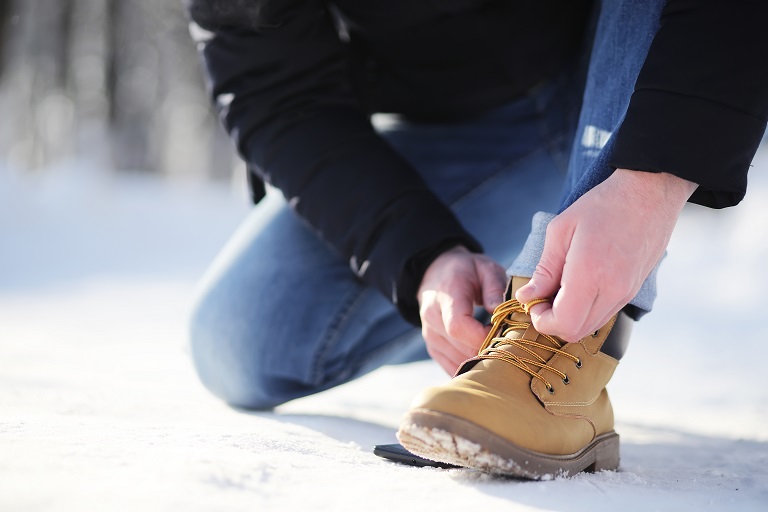How To Walk On Icy Streets Without Winter Boots

As the temperature drops and the outside is covered with snow, your walk to the shops may become a little more difficult than usual. Slipping and falling on ice can be humiliating, but it can also be dangerous. Accidents can be avoided by following a few easy procedures. Here are some winter safety tips for walking on snow & ice.
How To Walk On Icy Streets Without Winter Boots?
Use Caution
Approach with caution in cold weather and presume that all damp, dark places on pavements are slick and icy. Dew or water vapor can freeze, generating an ultra-thin, practically undetectable film of ice that resembles a wet spot on the pavement.
Walk On Designated Paths
Shortcutting through snowdrifts and other frozen places can be dangerous. When walking, keep an eye out for a snow or ice-covered sidewalk or driveway that may force you to proceed along its grassy edge for traction, especially if it is on a hill. It can be dangerous to take shortcuts via places where snow and ice clearance is not possible.
Use A Traction Agent
Use a reliable instant traction agent like Walk on ice. It will give you enough traction to walk safely on ice without using special footwear for walking on ice. Walk on Ice comes in convenient disposable canisters that can be taken with you wherever you go. It can be used on tires, sidewalks, and steps as an instant traction agent. It is easy to carry and can be used at any temperature and on any surface.
Balance Yourself
Bend slightly and walk flat-footed as much as possible, with your center of gravity precisely above your feet. To stay balanced, extend your arms out to the sides. If you’re carrying a hefty backpack or another burden, be aware that you may lose your balance.
Make sure your hands aren’t in your pockets. Walking with your hands out of your pockets lowers your center of gravity and improves balance. If you start to slip, you can use your hands to help break your fall.
Find Support.
When entering and departing cars, take extra precautions and rely on the vehicle for support. Always utilize the handrails and plant your feet firmly on each step when walking on stairs. For stability, take little steps or shuffle. It’s also a good idea to take a break now and again to break up the monotony.
Avoid Melted Snow And Ice.
Be cautious of melted snow and ice spots when walking on pavements. They may appear to be safe to walk on, yet they could be slippery.
Don’t try to save time by taking shortcuts.
When Cleats for Walking on Ice Become Handy
Even if you don’t have heavy-duty winter boots, you can still improve your grip by using cleats for walking on ice. These simple add-ons slip over your existing shoes and give you a temporary “tread boost.” They’re especially useful if you often need to walk across untreated sidewalks or parking lots. Just remember to remove them before stepping indoors, as they can be slippery on smooth tile or wood floors.
Sand for Snow and Ice – Does It Work?
Some people sprinkle sand for snow and ice as a budget-friendly solution. It can help with short-term traction by giving shoes something gritty to grab onto. But here’s the catch: sand doesn’t melt ice, and once it gets buried under fresh snowfall, you’ll need to reapply it again and again. Plus, it can leave behind quite a bit of mess when the thaw comes. It works in a pinch, but it’s not the cleanest or most effective long-term solution.
If you’re looking for the best of both worlds—traction without cleanup, Walk On Ice is often the smarter choice. Unlike sand, it doesn’t leave gritty residue behind, and unlike kitty litter, it doesn’t turn into mud when wet. That’s one reason many homeowners are now reserving sand strictly for emergencies or mixing it with other solutions instead of relying on it alone.
Does Kitty Litter Work on Ice?
You may have heard neighbors suggesting kitty litter for traction. The idea is that it adds grip the same way sand does. But in reality, it comes with its own headaches. Clay-based litter can turn into a wet, sludgy mess once it absorbs water, sometimes making the surface even slicker. If you want to test it, stick with traction-specific litters (like those made from silica or natural grit), but keep in mind that it’s really just a temporary workaround.
The Role of Instant Traction Agents
Instead of improvising with sand or kitty litter, many people now prefer instant traction agents like Walk On Ice. Unlike traditional fixes, it works immediately without creating residue that needs cleanup later. The dual action of “absorbers” and “grippers” locks into the icy surface, giving you a skid-free path whether you’re on stairs, sidewalks, or even stepping out of your car.
Call for Extra Help if Needed
Sometimes conditions are simply too risky to handle alone. If sidewalks are untreated or you’re worried about hidden ice beneath snow, don’t hesitate to ask for assistance—or even arrange for a local service to clear paths for you. Think of it as another safety precaution, just like wearing cleats or carrying a traction agent. Staying cautious is always smarter than taking a chance with a hard fall.
Unexpected Tech in Winter Safety—Call Gaia and “Ice Mode”
Here’s something interesting: some newer cars come with special drive settings like Ice Mode, which adjust braking and throttle response to prevent sliding. Handy, right? If your vehicle doesn’t have that, you can mimic the effect by applying gentle, steady pressure on the brakes instead of slamming them.
On the pedestrian side, apps like Call Gaia (which provides environmental and weather alerts) can help you stay updated on icy street conditions before you even step outside. Knowing when sidewalks are likely to be slick—early mornings and evenings, for example—can save you from an accident.
Conclusion
Walking on icy streets without winter boots is never ideal, but it doesn’t mean you’re helpless. With add-ons like cleats, grit options such as sand, or quick fixes like kitty litter, you can get by—but each comes with limits. For the most reliable protection, a traction agent like Walk On Ice gives you an instant, mess-free way to move safely. Combine it with careful steps, balance, and good awareness, and you’ll cut your risk of slips dramatically.
Get ready for winter with Walk On Ice instant traction on snow and ice
FAQs
Other Ice Melt Products
Safe Paw
The Original and #1 Selling Pet and Child Safe Ice Melt for over 20 years. Guaranteed environmentally safe – will not harm waterways and sensitive wetlands. All products are made in the USA.

Safe Thaw
Imagine an ice melt you can put down and never worry about. It won’t harm pets, kids, and your property. That’s Safe Thaw. Unlike anything else on the market, Safe Thaw can change how winter affects our planet.



